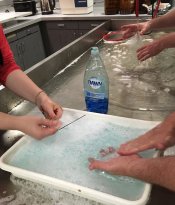Brian had sent us some chrome alum crystals to use as a hardener with the AG Plus emulsion. We finally got around to using the hardener on the latest shoot. We mixed up a 5% solution in distilled water and pre-soaked the exposed plates for 5 minutes followed by a 5 minute wash before developing. We had excellent results. There was zero emulsion lifting. Thanks for the suggestion. We will order up a jar of the crystals for future use.
We have been using washing soda (sodium carbonate) with a drop of photoflo 200 and Dawn to wash plates. This stuff MUST be washed off thoroughly, or the high ph will fog the plates severely. We also have been wiping the plates with 91% isopropyl alcohol after rinsing and drying with good results.
We also suspected our dark amber safelight was getting too close to the emulsion/plates and causing fogging. We redirected the safelight to bounce of the white walls of the darkroom. Fogging seemed much reduced.
Our Ilex Acme #4 shutter with a Schneider 210mm 1954-vintage single-coated lens was getting very balky. A new shutter was 4x the cost of a "new" used lens with a modern Copal shutter. We picked up a newer Schneider 210mm Symmar-S multicoated lens in a Copal #1 shutter (1983-vintage). Images are sharper with more contrast, but we do like the soft off-center effect of the older lens. The shutter is a dream to use compared to the 1954 Ilex.
Lighting is critical to good results (no surprise!). Best results are under full noon sun with subject shaded facing North. Shooting within a couple of hours before sunset or after sunrise makes exposures much more critical and variable. The first three images below were under ideal conditions.
We did a bit of research on how the Rockland "reversal" developer works. Apparently, the Ammonium Thiocyanate is the secret ingredient. It has a complex chemical effect on the developed silver such that very tiny "balls" of silver are formed in the exposed areas rather than tangled threads of metallic silver that form with conventional developer. The dimensions of the "balls" are on the order of the wavelengths of visible light, causing the exposed areas to render as light colored rather than dark. Ammonium Thiocyanate is commonly used in holographic developers so the interference pattern is preserved by the tiny sub-micron silver "balls".
We also are changing the developer and fixer after every plate. Since doing so, we have not been plagued by the metallic "comets" that can occur due to contamination of precipitated silver in used developer. We also rinse and clean the developer tray thoroughly between plates. It is well worth the effort and doesn't reduce the yield of a liter of developer by much if a small tray and minimal quantity of developer (40-50ml) is used per plate.
Some examples with the new lens (using a new scanner as well - more representative of actual tone and exposure):
Regards,
Don and Jenni
































